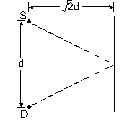8. Find the amplitude of vibration of the particles of air through which a sound wave of intensity
2.0 × 10–6 W/m2 and frequency 1.0 kHz is passing. Density of air = 1.2 kg/m3 and speed of sound in air = 330 m/s.
Sol. The relation between the intensity of sound and the displacement amplitude is

9. The sound level at a point is increased by 30 dB. By what factor is the pressure amplitude increased ?
Sol. The sound level in dB is
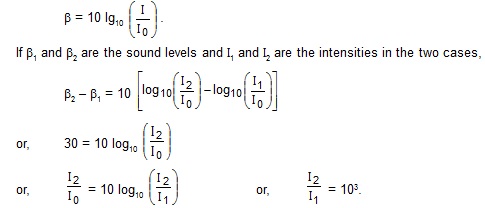
As the intensity is proportional to the square of the pressure amplitude,
we have
10. Figure shows a tube structure in which a sound signal is sent from one end and is received at the other end. The semicircular part has a radius of 20.0 cm. The frequency of the sound source can be varied electronically between 1000 and 4000 Hz. Find the frequencies at which maximum of intensity are detected. The speed of sound in air = 340 m/s.

Sol. The sound wave bifurcates at the junction of the straight and the semicircular parts. The wave through the straight part travels a distance L1 = 2 × 20 cm and the wave through the curved part travels a distance L2 = pie 20 cm = 62.8 cm before they meet again and travel to the receiver. The path difference between the two waves received is, therefore.
Del L = L2 – L1 = 62.8 cm – 40 cm = 22.8 cm = 0.228 m.
The wavelength of either wave is = 340/v. For constructive interference, ![]() , where n is an integer.
, where n is an integer.
or, 0.228 m = n340/v
or, v = n 1491.2 Hz = n 1490 Hz.
Thus, the frequencies with in the specified range which cause maximum of intensity are 1490 Hz and 2980 Hz.
11. A source emitting sound of frequency 180 Hz is placed in front of a wall at a distance of 2 m from it. A detector is also placed in front of the wall at the same distance from it. Find the minimum distance between the source and the detector for which the detector detects a maximum of sound. Speed of sound in air = 360 m/s.
Sol. The situation is shown in figure. Suppose the detector is placed at a distance of x meter from the source. The direct wave received from the source travels a distance of x meter. The wave reaching the detector after reflection from the wall has travelled a distance of
The path difference between the two waves is

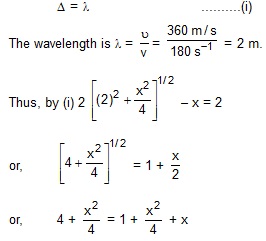
or, 3 = x.
Thus, the detector should be placed at a distance of 3 m from the source. Note that there is no abrupt phase change.
12. A tuning fork vibrates at 264 Hz. Find the length of the shortest closed organ pipe that will resonate with the tuning fork. Speed of sound in air is 350 m/s.
Sol. The resonant frequency of a closed organ pipe of length L is , where n is a positive odd integer and v is the speed of sound in air. To resonate with the given tuning fork,

For l to be minimum, n = 1 so that
13. The fundamental frequency of a closed organ pipe is equal to the first overtone frequency of an open organ pipe. If the length of the open pipe is 60 cm, what is the length of the closed pipe?
Sol. The fundamental frequency of a closed organ pipe is . For an open pipe, the fundamental frequency is and the first overtone is = . Here l1 is the length of the closed pipe and l2 = 60 cm is the length of the open pipe. We have,
=
l1 = × 60 cm = 15 cm.
14. A tuning fork vibrating at frequency 800 Hz produces resonance in a resonance column tube. The upper end is open and the lower end is closed by the water surface which can be varied. Successive resonances are observed at lengths 9.75 cm, 31.25 cm and 52.75 cm. Calculate the speed of sound in air from these data.
Sol. For the tube open at one end, the resonance frequencies are nv/4L , where n is a positive odd integer. If the tuning fork has a frequency v and L1, L2, L3 are the successive lengths of the tube in resonance with it, we have

By the question,L3 – L2 = (52.75 – 31.25) cm = 21.50 cm
and L2 – L1 = (31.25 – 9.75) cm =21.50 cm
thus, f/2v= 21.50
or, f= 2v × 21.50 cm = 2 × 21.50 cm = 344 m/s.
15. A certain organ piperesonates in its fundamental mode at a frequency of 500 Hz in air. What will be the fundamental frequency if the air is replaced by hydrogen at the same temperature ? The density of air is 1.20 kg/m3 and that of hydrogen is 0.089 km/m3.
Sol. Suppose the speed of sound in hydrogen is uh and that in air is ua. The fundamental frequency of an organ pipe is proportional to the speed of sound in the gas contained in it. If the fundamental frequency with hydrogen in the tube is v, we have
![]()
or, v = 3.67 × 500 Hz » 1840 Hz.
16. An aluminium rod having a length of 90.0 cm is clamped at its middle point and is set into longitudinal vibrations by stroking its with a rosined cloths. Assume that the of vibrates in its fundamental mode of vibration. The density of aluminium is 2600 kg/m3 and its Young’s modulus is 7.80 × 1010 N/m2. Find (a) the speed of sound in aluminium, (b) the wavelength of sound waves produced in the rod, (c) the frequency of the sound produced and (d) the wavelength of the sound produced in air. Take the speed of sound in air to be 340 m/s.
Sol. (a) The speed of sound in aluminium is

= 5480 m/s.
(b) Since the rod is clamped at the middle, the middle point is a pressure antinode. The free ends of the rod are the nodes. As the rod vibrates in its fundamental mode, there are no other nodes or antinodes. The length of the rod, which is also the distance between the successive nodes, is, therefore, equal to half the wavelength. Thus, the wavelength ofsound in the aluminium rod is
L = 2L = 180 cm
(c) The frequency of the sound produced which is also equal to the frequency of vibration of the rod is
![]()
(d) The wavelength of sound in air is
![]()
17. The string of a violin emits a note of 440 Hz at its correct tension. The string is bit taut and produces 4 beats per second with a tuning fork of frequency 440 Hz. Find the frequency of the note emitted by this taut string.
Sol. The frequency of vibration of a string increases with increase in the tension. Thus, the note emitted by the string will be a little more than 440 Hz. As it produces 4 beats per second with the 440 Hz tuning fork, the frequency will be 444 Hz.
18. A siren is fitted on a car going towards a vertical wall at a speed of 36 km/h. A person standing on the ground, behind the car, listens to the siren sound coming directly from the source as well as that coming after reflection from the wall. Calculate the apparent frequency of the wave(a) coming directly from the siren to the person and (b) coming after reflection. Take the speed of sound to be 340 m/s.
Sol. 
The speed of the car is 36 km/h = 10 m/s.
(a) Here the observer is at rest with respect to the medium and the source is going away from the observer. The apparent frequency heard by the observer is, therefore,

The wall reflects this sound without changing the frequency. Thus, the frequency of the reflected wave as heard by the ground observer is 515 Hz.
19. Two trains are moving towards each other at speeds of 72 km/h and 54 km/h relative to the ground. The first train sounds a whistle of frequency 600 Hz. Find the frequency of the whistle as heard by a passenger in the second train. (a) before the trains meet and (b) after the trains have crossed each other. The speed of sound in air is 340 m/s.
Sol. The speed of the first train = 72 km/h = 20 m/s and that of the second = 54 km/h = 15 m/s.
(a) Here both the source and the observer move with respect to the medium. Before the trains meet, the source is going towards the observer and the observer is also going towards the source. The apparent frequency heard by the observer will be
![]()
(b) After the trains have crossed each other, the source goes away from the observer and the observer goes away from the source. The frequency heard by the observer is, therefore,
![]()
20. A person going away from a factory on his scooter at a speed of 36 km/h listens to the siren of the factory. If the main frequency of the siren is 600 Hz and a wind is blowing along the direction of the scooter at 36 km/h, find the main frequency as heard by the person.
Sol. The speed of sound in still air is 340 m/s. Let us work from the frame of reference of the air. As both the observer and the wind are moving at the same speed along the same direction with respect to the ground, the observer is at rest with respect to the medium. The source (the siren) is moving with respect to the wind at a speed of 36 km/h i.e., 10 m/s. As the source is going away from the observer who is at rest with respect to the medium, the frequency heard is
![]()
21. A source and a detector move away from each other, each with a speed of 10 m/s with respect to the ground with no wind. If the detector detects a frequency 1950 Hz of the sound coming from the source, what is the original frequency of the source? Speed of sound in air = 340 m/s.
Sol. If the original frequency of the source is v, the apparent frequency heard by the observer is
![]()
where u0 is the speed of the observer going away from the source and us is the speed of the source going away from the observer. By the question,
1950 Hz =![]()
v = 35/33× 1950 Hz = 2070 Hz.
22. The driver of a car approaching a vertical wall notices that the frequency of his car’s horn changes from 440 Hz to 480 Hz when it gets reflected from the wall. Find the speed of the car if that of the sound is 330 m/s.
Sol. 
Suppose, the car is going towards the wall at a speed u. The wall is stationary with respect to the air and the horn is going towards it. If the frequency of the horn is v, that received by the wall is
![]()
The wall reflects this sound without changing the frequency. Thus, the wall becomes the source of frequency v¢ and the car-driver is the listener. The wall (which acts as the source now) is at rest with respect to the air and the car (which is the observer now) is going towards the wall at speed u. The frequency heard by the car-driver for this reflected wave is, therefore,
![]()
Putting the values,
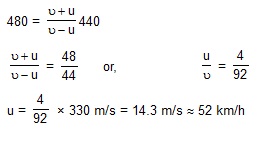
23. A train approaching a railway crossing at a speed of 120 km/h sounds a short whistle at frequency 640 Hz when it is 300 m away from the crossing. The speed of sound in air is 340 m/s. What will be the frequency heard by a person standing on a road perpendicular to the track through the crossing at a distance of 400 m from the crossing ?
Sol. 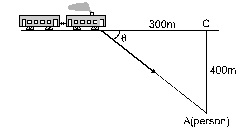
The observer A is at rest with respect to the air and the source is travelling at a velocity of 120 km/h i.e., 100/3m/s. As is clear from the figure, the person receives the sound of the whistle in a direction BA making an angle theta with the track where cos theta = 300/500 = 3/5. The component of the velocity of the source (i.e., of the train) along this solution AB is 100/3 × 3/5m/s = 20 m/s. As the source is approaching the person with this component, the frequency heard by the observer is
![]()
1. A steel tube of length 1.00 m is struck at one end. A person with his ear close to the other end hears the sound to the blow twice, one travelling through the body of the tube and the other through the air in the tube. Find the time gap between the two hearings. Use the table in the text for speeds of sound in various substances.
Ans. 2.75 ms
2. At a prayer meeting, the disciples sing JAI-RAM, JAI-RAM. The sound amplified by a loudspeaker comes back after reflection from a building at a distance of 80 m from the meeting. What minimum time interval can be kept between one JAI-RAM and the next JAI-RAM so that the echo does not disturb a listener sitting in the meeting. Speed of sound in air is 320 m/s. [3 min.]
Ans. 0.5 s
Sol
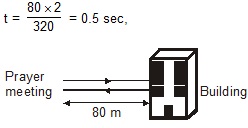
3. A man stands before a large wall at a distance of 50.0 m and claps his hands at regular intervals. Initially, the interval is large. He gradually reduces the interval and fixes it at a value when the echo of a clap merges with the next clap. If he has to clap 10 times during every 3 seconds, find the velocity of sound in air.
Ans. 333 m/s
4. A person can hear sound waves in the frequency range 20 Hz to 20 kHz. Find the minimum and the maximum wavelengths of sound that is audible to the person. The speed of sound is 360 m/s.
Ans. 18 mm, 18 m
5. Find the minimum and maximum wavelengths of sound in water that is in the audible range
(20 - 20000 Hz) for an average human ear. Speed of sound in water = 1450 m/s.
Ans. 7.25 cm, 72.5 m
6. Sound waves from a loudspeaker spread nearly uniformly in all directions if the wavelength of the sound is much larger than the diameter of the loudspeaker. (a)Calculate the frequency for which the wavelength of sound in air is ten times the diameter of the speaker if the diameter is 20 cm. (b) Sound is essentially transmitted in the forward direction if the wavelength is much shorter than the diameter of the speaker. Calculate the frequency at which the wavelength of the sound is one tenth of the diameter of the speaker described above. Take the speed of sound to be 340 m/s.
Ans. (a) 170 Hz (b) 17 kHz
7. Ultrasonic waves of frequency 4.5 MHz are used to detect tumour in soft tissues. The speed of sound in tissue is 1.5 km/s and that in air is 340 m/s. Find the wavelength of this ultrasonic wave in air and in tissue.
Ans. 7.6 × 10–5 m, 3.3 × 10–4 m
8. The equation of a travelling sound wave is y = 6.0 sin (600 t – 1.8 x) where y is measured in 10–5 m, t in second and x in metre. (a) Find the ratio of the displacement amplitude of the particles to the wavelength of the wave. (b) Find the ratio of the velocity amplitude of the particles to the wave speed.
Ans. (a) 1.7 × 10–5 m, 3.3 × 10–4 m
9. A sound wave of frequency 100 Hz is travelling in air. The speed of sound in air is 350 m/s. (a) By how much is the phase changed at a given point in 2.5 ms? (b) What is the phase difference at a given instant between two points separated by a distance of 10.0 cm along the direction of propagation ?
![]()
10. Two points sources of sound are kept at a separation of 10 cm. They vibrate in phase to produce waves of wavelength 5.0 cm. What would be the phase difference between the two waves arriving at a point 20 cm from one source (a) on the line joining the sources and (b) on the perpendicular bisector of the line joining the sources?
Ans. (a) zero (b) zero
11. Calculate the speed of sound in oxygen from the following data. The mass of 22.4 litre of oxygen at STP (T = 273 K and p= 1.0 × 105 N/m2) is 32 g, the molar heat capacity of oxygen at constant volume is Cv = 2.5 R and that at constant pressure is Cp = 3.5 R.
Ans. 310 m/s
12. The speed of sound as measured by a student in the laboratory on a winter day is 340 m/s when the room temperature is 17°C. What speed will be measured by another student repeating the experiment on a day when the room temperature is 32°C?
Ans. 349 m/s
13. At what temperature will the speed of sound be double of its value at 0°C?
Ans. 819°C
14. The absolute temperature of air in a region linearly increases from T1 to T2 in a space of width d. Find the time taken by a sound wave to go through the region in terms of T1, T2 and the speed v of sound at 273 K. Evaluate this time for T1 = 280 K, T2 = 310 K, d = 33 m and v = 330 m/s.
Ans. ![]()
15. Find the change in the volume of 1.0 litre kerosene when it is subjected to an extra pressure of 2.0 × 105 N/m2 from the following data. Density of kerosene = 800 kg/m3 and speed of sound in kerosene is 1330 m/s.
Ans. 0.14 cm3
16. Calculate the bulk modulus of air from the following data about a sound wave of wavelength 35 cm travelling in air. The pressure at a point varies between (1.0 × 105 ± 14) Pa and the particles of the air vibrate in simple harmonic motion of amplitude 5.5 × 10–6 m.
Ans. 1.4 × 105 N/m2
17. A source of sound operates at 2.0 kHz, 20 W emitting sound uniformly in all directions. The speed of sound in air is 340 m/s and the density of air is 1.2 kg/m3.
(a) What is the intensity at a distance of 6.0 m from the source?
(b) What will be the pressure amplitude at this point?
(c) What will be the displacement amplitude at this point?
Ans. (a) 44 mW/m2 (b) 6.0 Pa (c) 1.2 × 10–6 m
18. The intensity of sound from a point source is 1.0 × 10–8 W/m2 at a distance of 5.0 m from the source. What will be the intensity at a distance of 25 m from the source?
Ans. 4.0 × 10–10 W/m2
19. The sound level at a point 5.0 m away from a point source is 40 dB. What will be the level at a point 50 m away from the source?
Ans. 20 dB
20. If the intensity of sound is doubled, by how many decibels does the sound level increase?
Ans. 3 dB
21. Sound with intensity larger than 120 dB appears painful to a person. A small speaker deliveries 2.0 W of audio output. How close can the person get to the speaker without hurting his ears?
Ans. 40 cm
22. If the sound level in a room is increased from 50 dB to 60dB, by what factor is the pressure amplitude increased?
Ans. 100.5
23. The noise level in a class-room in absence of the teacher is 50 dB when 50 students are present. Assuming that on the average each student output same sound energy per second, what will be the noise level if the number of students is increased to 100 ?
Ans. 53 dB
24. In a Quincke’s experiment the sound detected is changed from a maximum to a minimum when the sliding tube is moved through a distance of 2.50 cm. Find the frequency of sound if the speed of sound in air is 340 m/s.
Ans. 3.4 kHz
25. In a Quincke’s experiment, the sound intensity has a minimum value I at a particular position. As the sliding tube is pulled out by a distance of 16.5 mm, the intensity increases to a maximum of
9I. Take the speed of sound in air to be 330 m/s. (a) Find the frequency of the sound source.
(b) Find the ratio of the amplitudes of the two waves arriving at the detector assuming that it does not change much between the positions of minimum intensity and maximum intensity.
Ans. (a) 5.0 kHz (b) 2
26. Two audio speakers are kept some distance apart and are driven by the same amplifier system. A person is sitting at a place 6.0 m from one of the speakers and 6.4 m from the other. If the sound signal is continuously varied from 500 Hz to 5000 Hz, what are the frequencies for which there is a distractive interference at the place of the listener? Speed of sound in air = 320 m/s.
Ans. 1200 Hz, 2000 Hz, 2800 Hz, 3600 Hz and 4400 Hz
27. A source of sound S and a detector D are placed at some distance from one another. A big cardboard is placed near the detector and perpendicular to the line SD as shown in figure. It is gradually moved away and it is found that the intensity changes from a maximum to a minimum as the board is moved through a distance of 20 cm. Find the frequency of the sound emitted. Velocity of sound in air is 336 m/s.

Ans. 420 Hz
28. A source S and a detector D are placed at a distance d apart. A big cardboard is placed at a distance H from the source and the detector as shown in figure. The source emits a wave of wavelength = d/2 which is received by the detector after reflection from the cardboard. It is found to be in phase with the direct wave received from the source. By what minimum distance should the cardboard be shifted away so that the reflected wave becomes out of phase with the direction wave?
Ans. 0.13 d
